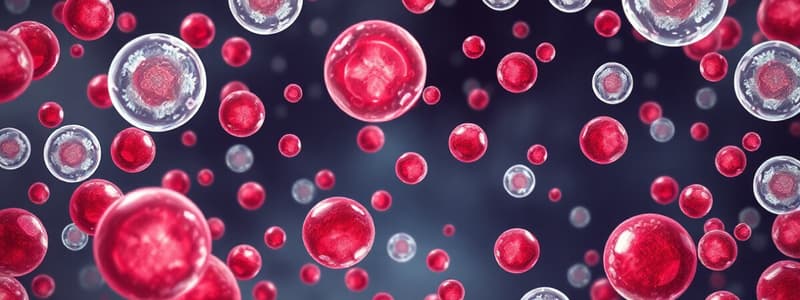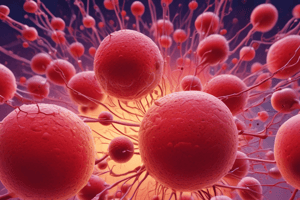Podcast
Questions and Answers
Which of the following mechanisms is LEAST directly involved in preventing platelet aggregation by healthy endothelial cells?
Which of the following mechanisms is LEAST directly involved in preventing platelet aggregation by healthy endothelial cells?
- Secretion of adenosine diphosphatase (ADPase).
- Expression of thrombomodulin.
- Secretion of tissue plasminogen activator (tPA). (correct)
- Production of nitric oxide (NO).
Which of the following scenarios would MOST directly impair the ability of platelets to form a stable plug at the site of vascular injury?
Which of the following scenarios would MOST directly impair the ability of platelets to form a stable plug at the site of vascular injury?
- Deficiency in adenosine diphosphate (ADP) release from dense granules. (correct)
- Increased secretion of tissue plasminogen activator (tPA) by endothelial cells.
- Overexpression of thrombomodulin on endothelial cells.
- Enhanced production of nitric oxide (NO) by endothelial cells.
Which of the following effects would be MOST likely to result from a mutation that impairs the ability of platelets to change shape upon activation?
Which of the following effects would be MOST likely to result from a mutation that impairs the ability of platelets to change shape upon activation?
- Impaired release of ADP from dense granules.
- Reduced surface area for coagulation factor assembly. (correct)
- Increased binding affinity for von Willebrand factor (vWF).
- Decreased expression of Tissue Factor.
A researcher is investigating the effects of a novel drug on hemostasis. The drug is found to inhibit the movement of phospholipids to the platelet surface. Which aspect of clot formation would be MOST directly affected by this drug?
A researcher is investigating the effects of a novel drug on hemostasis. The drug is found to inhibit the movement of phospholipids to the platelet surface. Which aspect of clot formation would be MOST directly affected by this drug?
In the context of secondary hemostasis, what is the MOST direct role of Tissue Factor (TF) exposed by damaged cells?
In the context of secondary hemostasis, what is the MOST direct role of Tissue Factor (TF) exposed by damaged cells?
A patient presents with a condition that impairs the function of alpha granules within platelets. Which of the following processes would be MOST directly compromised in this patient?
A patient presents with a condition that impairs the function of alpha granules within platelets. Which of the following processes would be MOST directly compromised in this patient?
Which of the following mechanisms is LEAST directly associated with the role of von Willebrand factor (vWF) in hemostasis?
Which of the following mechanisms is LEAST directly associated with the role of von Willebrand factor (vWF) in hemostasis?
A drug that inhibits the function of Glycoprotein IIb/IIIa (GPIIb/IIIa) receptors would MOST directly interfere with which of the following processes?
A drug that inhibits the function of Glycoprotein IIb/IIIa (GPIIb/IIIa) receptors would MOST directly interfere with which of the following processes?
What is the primary role of thrombin in secondary hemostasis?
What is the primary role of thrombin in secondary hemostasis?
Which event is LEAST likely to occur as part of the initial vascular spasm (neurogenic reflex) following a blood vessel injury?
Which event is LEAST likely to occur as part of the initial vascular spasm (neurogenic reflex) following a blood vessel injury?
Flashcards
What are Platelets?
What are Platelets?
Cytoplasmic fragments from megakaryocytes in bone marrow, crucial for clotting.
What do Endothelial Cells do?
What do Endothelial Cells do?
Regulate hemostasis by preventing unnecessary clotting.
What is von Willebrand Factor (vWF)?
What is von Willebrand Factor (vWF)?
Binds platelets to exposed collagen at injury sites, aids Factor VIII.
What do Platelet Granules contain?
What do Platelet Granules contain?
Signup and view all the flashcards
What is Secondary Hemostasis?
What is Secondary Hemostasis?
Signup and view all the flashcards
How is primary hemostasis done?
How is primary hemostasis done?
Signup and view all the flashcards
What is Adenosine Diphosphatase (ADPase)?
What is Adenosine Diphosphatase (ADPase)?
Signup and view all the flashcards
What do Heparin-like Molecules do?
What do Heparin-like Molecules do?
Signup and view all the flashcards
What is the direct role of Tissue Factor (TF)?
What is the direct role of Tissue Factor (TF)?
Signup and view all the flashcards
What would impaired alpha granules do?
What would impaired alpha granules do?
Signup and view all the flashcards
Study Notes
Platelets
- Platelets are cytoplasmic fragments originating from megakaryocytes in the bone marrow.
- Megakaryocytes remain in the bone marrow and release small pieces of cytoplasm into circulation as platelets.
- Platelets are anucleated and contain granules storing key molecules for clotting.
- On stained blood smears, platelets appear as small, purplish-pink structures.
Platelet Granules
- Platelets contain granules (dense and alpha granules), which are specialized storage compartments containing various substances necessary for their activation and function during clot formation.
Dense Granules
- Dense granules contain ADP, calcium, ATP, serotonin, and epinephrine.
- ADP is released upon platelet activation, promoting platelet aggregation by binding to P2Y12 receptors.
- ADP works with thromboxane A2 (TXA2) to enhance platelet adhesion and aggregation.
- Calcium helps activate enzymes and proteins involved in platelet shape change, aggregation, and the coagulation cascade.
- Calcium is also crucial for activating coagulation factors and platelet contraction during aggregation.
Alpha Granules
- Alpha granules contain clotting factors like fibrinogen and von Willebrand factor (vWF)
- Fibrinogen is converted to fibrin by thrombin, forming a mesh that stabilizes the platelet plug.
- vWF helps platelets adhere to exposed collagen and acts as a carrier for factor VIII
- Alpha granules also contain modulatory factors like platelet-derived growth factor (PDGF)
Significance of Granules in Platelet Function
- Both dense and alpha granules are vital for platelet activation and aggregation.
- ADP and calcium initiate platelet activation, while fibrinogen, vWF, and growth factors stabilize the clot and promote healing.
- Granule contents amplify the hemostatic response, especially ADP.
- Alpha granules contribute to clot integrity with clotting factors like fibrinogen and vWF.
- Growth factors from alpha granules stimulate blood vessel and tissue regeneration for proper healing.
Platelet Surface Receptors
- Platelets possess glycoprotein receptors for interacting with clotting factors and each other.
- Glycoprotein receptors play a vital part in platelet adhesion, activation, and aggregation.
- When a blood vessel is injured, vWF binds to GPIb on platelets, initiating adhesion to the damaged vessel wall.
- Upon platelet activation, GPIIb/IIIa receptors bind fibrinogen, connecting adjacent platelets.
- GPIIb/IIIa allows platelets to stick to each other and form aggregates
Endothelial Cells
- Endothelial cells lining blood vessels regulate hemostasis, preventing unnecessary clotting.
- Endothelial cells secrete:
- Tissue Plasminogen Activator (tPA) promoting fibrinolysis
- Vasodilators like Prostacyclin and Nitric Oxide, keeping vessels open
- Adenosine Diphosphatase (ADPase) breaking down ADP
- Endothelial cells express Thrombomodulin, Heparin-like Molecules and Tissue Factor Pathway Inhibitor (TFPI) for anticoagulation.
Hemostasis Process
- Hemostasis process occurs in response to Injury
Hemostasis - Initial Response
- Vascular Spasm (Neurogenic Reflex & Vasoconstriction) upon injury.
Primary Hemostasis
- Platelet Plug Formation occurs, in three steps:
- Adhesion: Platelets bind to von Willebrand factor (vWF) via Glycoprotein Ib (GpIb) receptor.
- Platelet Activation: Platelets change shape leading to Granules release ADP and thromboxane A₂ to recruit more platelets.
- Platelet Aggregation: Platelets bind to each other using Glycoprotein IIb/IIIa (GpIIb/IIIa) receptors.
Mnemonic
- “One binds first" → GpIb binds to vWF first.
- "Two-three" (GpIIb/IIIa) needed for aggregation.
Secondary Hemostasis
- Stable Clot Formation:
- Tissue Factor is exposed, activating the coagulation cascade.
- The coagulation cascade is a series of events that leads to formation of a stable blood clot after primary hemostasis
- Thrombin is generated, converting fibrinogen to fibrin.
Clot Stabilization & Resolution
- Fibrin mesh strengthens the clot.
- Fibrinolysis occurs to restore normal blood flow.
- Plasmin breaks down fibrin into fibrin degradation products (FDPs), which dissolve the clot and allow the blood vessel to return to normal.
Studying That Suits You
Use AI to generate personalized quizzes and flashcards to suit your learning preferences.




